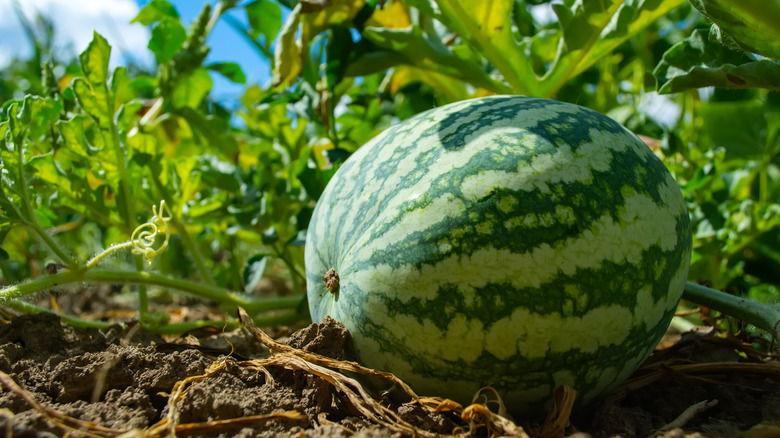The Unexpected Reason Ancient Egyptians First Grew Watermelon
With modern-day melon farms and advanced cultivation techniques, it's hard to imagine watermelons growing in the wild. But that's apparently what they once did in the time of ancient Egypt — and still do in northeast African countries such as Sudan, according to the Times of Israel. But wild watermelons are quite different from the sweet, red-fleshed versions we sweep up at supermarkets and farmers' stands today. A 2015 study published in Annals of Botany describes the flesh of wild-grown watermelons as having a hard texture, pale color, and either a bitter or bland taste. So why would ancient Egyptians want to cultivate and consume them?
We know today that watermelons harbor a colony of nutrients inside that thick outer rind, making them an excellent source of potassium, magnesium, thiamine, and vitamins C, A, and B6, per the National Watermelon Promotion Board. They also contain high amounts of citrulline, which may improve muscle mass, and lycopene for heart and skin health, explains WebMD. Thousands of years ago, Egyptians may not have been privy to that information — but they had equally important reasons for growing the massive nutritious melons.
Desert heat leads to watermelon cultivation
The obvious hint as to why long-ago Egyptians cultivated watermelons lies in the name we call them today. Healthline states that watermelons are 92% water, a pretty big benefit for a country whose total area consists of 96% percent desert, per Britannica. They were a life-saving source of hydration for Egyptians, with the ability to survive the hottest, driest seasons when stored in the shade, according to National Geographic. As for the bitter taste and unappealing texture, that disappeared with selective breeding over thousands of years.
A DNA study mentioned in New Scientist shows that watermelons were being cultivated in Egypt at least 3500 years ago, based on a watermelon leaf discovered in an Egyptian tomb. It served as a DNA sample for sequencing and comparison with modern-day watermelon varieties. Results confirmed that our current red and sweet versions of watermelon were closely related to the ones domesticated in Egypt.
Another juicy archaeological tidbit came with the discovery of watermelon seeds in the tomb of Egyptian King Tutankhamun, who was buried 3300 years ago, according to the Times of Israel. About 1000 years prior, an Egyptian tomb painting also featured watermelon as a dessert. Harry Paris, a horticulturalist at the Agricultural Research Organization in Israel, offered National Geographic a glimpse into Egyptian afterlife perceptions and why watermelons appeared in burial scenes. Egyptian pharaohs, he said, had a long journey after death and would need water along the way. Voila — watermelons.

